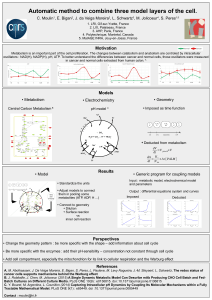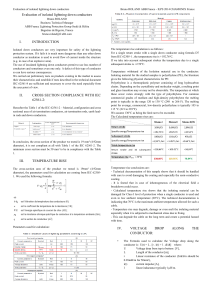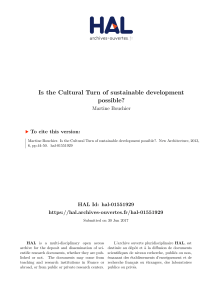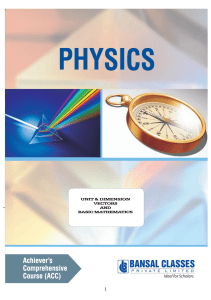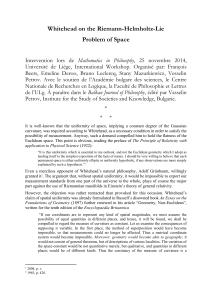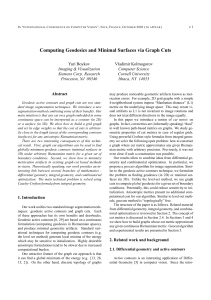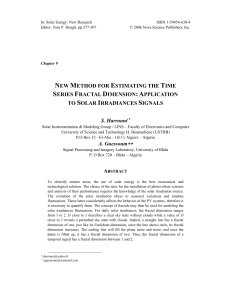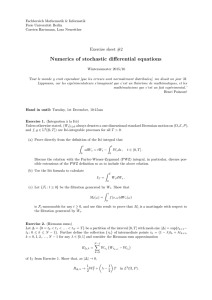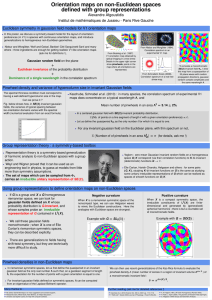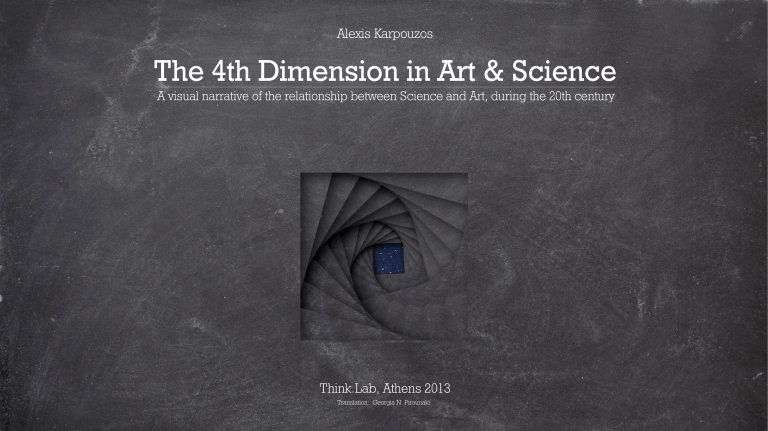
Alexis Karpouzos The 4th Dimension in Art & Science A visual narrative of the relationship between Science and Art, during the 20th century Think.Lab, Athens 2013 Translation: Georgia N. Pirounaki “To see a world in a grain of sand and a heaven in a wild flower hold infinity in the palm of your hand and eternity in an hour” William Blake Einstein’s Universe Van Gogh’s Universe “And I am dumb to tell a weather’s wind How time has ticked a heaven round the stars. And I am dumb to tell the lover’s tomb How at my sheet goes the same crooked worm.” Dylan Thomas “A magnitude if divisible one way is a line, if two ways a surface, and if three a body. Beyond these there is no other magnitude because the three dimensions are all that there is and that which is divisible in three directions is divisible in all.” Aristotle, Uranya Euclid in “Elements” doesn’t see a possibility of an additional dimension. However, the 4th dimension, as a geometric possibility, is introduced by Euclid’s fifth postulate, known as the parallel postulate. Ptolemy in “About distance” mathematically proved that more dimensions do not exist. Kepler (1596) expressed the thought that the obvious preference of nature for three dimensions, has to do with the fact that the Holy Trinity itself exists in a nature of three people or three hypostases. In 1843, the German mathematician August Möbius suggested the existence of a 4th dimension so that the “right-oriented” objects of our 3-dimensional world can be transformed to their symmetrical “left-oriented” and vice versa. Edwin Abbott in his novel “Flatland, a Romance of Many Dimensions” (1880), challenges us to imagine how it would feel to see our world from the 4th dimension. His hero, a square, who lives in a 2-dimensional space, the flatland, is visited by a sphere from the 3-dimensional space, who is responsible for introducing the square to the brave world of the third dimension. “Time present and time past Are both perhaps present in time future, And time future contained in time past.” In Eliot’s “Wasteland”, every measurement of space and time is considered relevant. Eliot suggests that “the idea of the separate dimension of the absolute time” is the fourth dimension. The idea of a united spacetime is declared by Edgar Allan Poe in his essay about cosmology entitled “Eureka” (1848) as follows: “Space and duration are one.” Marcel Proust in his novel “Swann’s Way”, which was published in 1913, describes the church which is located in the village he used to visit as a child, like: “... A building which occupied, so to speak, four dimensions of space – the name of the fourth being Time...” In “Time Machine” (1895) by H.G.Wells time is faced as the 4th dimension. According to Wells, a body cannot have instant physical hypostasis. A body being observed is, for each given moment, a depiction of a 4-dimensional object which must have “Length, Breadth, Thickness and … Duration”. There is no difference between time and every one of the other three space dimensions, apart from the fact that our consciousness moves along it. If it was possible to observe a man from an external – to the everyday – spacetime point, then the past, the present and the future would possibly become known. Moreover, in Wells’ “The Invisible Man” (1897), the hero drinks a filter “containing 4 dimensions” in order to become invisible. Gauss discovered an amount of relations that may be used in order to describe shape properties, irrespective of the surface in which the shapes were designed. Gauss, in these relations, used the curvature factor (ε) in order to combine the different surfaces (i.e. flat, hyperbolic and spherical triangle). We have to note that we are talking about shapes which, no matter in what kind of surface are created, they are shaped in a 3-dimensional Euclidean space. This is proved by the fact that these properties, through the curvature factor (ε), are related to the general Euclidean types. As for the case of a spherical surface, the curvature factor remains positive (ε>0), while at the hyperbolic surface it remains negative (ε<0). For the flat, it is zero (ε=0). The first attempt to create a non-Euclidean geometry was made by Janos Bolyai. For Bolyai, the definition of parallels and their properties is given irrespective of the 5th postulate. “Out of nothing, I have created a strange, new universe.” The Russian mathematician Lobachevsky tried to prove the fifth of the Euclidean postulates, using proof by contradiction, however, without ending in any inconsistency. This meant that if we accept a contrary to the fifth postulate idea, we can develop a chain of theorems that will not contain any inner inconsistency. The transition from the Euclidean geometry to Lobachevsky’s hyperbolic geometry is achieved by replacing the parallel postulate (Euclid’s request) with the following postulate: Through a point not on a line, infinite lines that will not cross it can be drawn. The two external of the infinite lines, that do not cross the given line, are called parallels. Thus, the postulate can be also expressed as following: If L is any line and P is any point not on L, then there exist at least two lines through P that are parallel to L. Bernhard Riemann mathematically formulated the multi-dimensional space in his book “On the Hypotheses which lie at the Basis of Geometry”. Riemann’s geometry generalizes Lobachevsky’s geometry. It is of interest to state that at Riemann’s geometry, apart from the fifth Euclidean postulate, the validity of the first Euclidean postulate on which it is based (i.e. there is only one line connecting two points) shouldn’t be accepted either. Riemann’s space is not always homogenous on its properties, i.e. it does not always present a fixed curvature. This means that in Riemann’s space, a shape cannot move without having the distances between its points transformed. In this geometry, from a point not on a line, it is impossible for any line to be drawn parallel to it. Riemann’s ideas concerning n-dimensional spaces were seen with hesitation and reservation at first. However, they were gradually accepted by the scientific and public consciousness, during the last half of the 19th century. William Clifford and Hermann von Helmholtz, who were publicly arguing over the idea of a universe with more than three dimensions, contributed a lot to this twist. William Clifford moved forward Riemann’s idea concerning the fact that electric and magnetic forces exist due to space curvature. Clifford believed that higher dimensional spaces (from the mathematical field) and electromagnetism (from science field) are absolutely the same thing. Riemann and Clifford managed to form a picture of nature based on the idea that force is nothing more than space curvature (i.e. it can be geometrically interpreted in an absolute way) and electromagnetism can be explained by this point of view as an “oscillation” in an additional space dimension. In 1870 the German physicist Herman von Helmholtz simplified the meaning of Euclidean space and of most dimensions. He questioned Kant’s theory which supported that the geometry of natural space was an a priori form of human thought, and as a result Euclidean. Herman von Helmholtz suggested that our knowledge about space is a belief which coincides with our understanding of the world. The French mathematician Henri Poincaré gave an answer to the question: “Is Euclidean geometry true?” “It has no meaning. We might as well ask if the metric system is true, and if the old weights and measures are false; if the Cartesian co-ordinates are true and polar co-ordinates false. The geometrical axioms are not experimental facts. On the contrary, observing several natural phenomena leads to a selection of some assumptions among all the possible ones… The ones selected are simply the most convenient and no one can tell that Euclidean geometry is true and Lobachevsky’s is false. One geometry cannot be more true than another; it can only be more convenient.” For Kant, on the other hand, Euclidean geometry is inherent to the construction of human mind, inherited a priori; it is not a result of experience. Poincaré supported that we create geometry according to the stimuli we get. Through natural selection, our spirit was adapted to the conditions of the external world and adopted the more favorable geometry for our species, the most appropriate in other words. Our geometry is not true, it is favorable! If a cube is unfolded in a 2-dimensional space, it will look like this… How would a hypercube look, if unfolded in a 3-dimensional space? ? The mathematician Charles Howard Hinton tried in his work “The Fourth Dimension” (1904) to represent “the first non-geometrical depiction of the 4th dimension” using constructions like the tesseract (i.e. an unfolding of a 4-dimensional hypercube in the 3-dimensional space). With this, Hinton played an important role in the popularization of the 4th dimension. According to Hinton, if someone developed “his mental inner eye”, he would realize a 4-dimensional reality. What’s more, the 4-dimensional experience, “must be connected with time experience in three space”. Hinton composed a full 4-dimensional thought system in engineering, science and art and founded a “Hyperspace Philosophy”, which influences spaces that study mysticist and transcendental elements. Hinton strongly believed that if a being was able to move unhindered in the fourth dimension, he could appear and disappear willingly. In Dali’s “The Persistence of Memory”, the “melting watches” constitute an inconscient symbol of space and time relativity, a surrealist meditation on the collapse of our notions of a fixed cosmic order. This happened “since the theory of relativity enthroned and thus brought time back to its relative role already accorded to Heraclitus.” Dali tried to depict the space time correlations through art. In the painting “Corpus Hypercubus” (1954) he presents Jesus on a hypercube that looks like a cross. In that painting, the hint on God-man’s true nature becomes easily obvious. The mystery of his divine nature lies in the strings of the non distinct nature of the 4-dimensional hyperspace. What we comprehend is the depiction of the hyperconceivable being in the 3-dimensional space. In the same painting of Dali, the floor is a chessboard with black and white tiles… but right below the Crucifix, there is a cross-shaped shadow, as if there exists an invisible light from the top. In 1907 Pablo Picasso in his painting “Ladies of Avignon” goes round his subject 180o and composes his perception in a unique picture, which resulted in what was called “simultaneous vision”. Claude Monet was one of the most distinguished representatives of Impressionism. During the decades of 1880 and 1890, Monet started creating a series of paintings, which shared a common subject. Monet experimented with the perception of time. He showed how an object changes as time goes by. He began painting scenes observed from the same place, but at a different time of the day, or even in different seasons. Gare Saint-Lazare, 1877 The art movement of Cubism for the first time presented a new way of understanding space since Euclid’s era, 2300 years ago. The artists of cubism combined Monet’s single perspective drawings in a multiple perspective drawing. Violin, Picasso, 1912 Multiple drawings, one perspective. One drawing, multiple perspectives. It is believed that the appearance of the subjects on Picasso’s paintings (which can be seen simultaneously from many directions) was affected by the ideas about the fourth dimension. In cubism, the objects are deconstructed in visual debris and they are afterwards rearranged in a way that the viewer doesn’t need to move in space or time in order to see them. All parts from all visual corners – in the front-ground, in the background, above, below, on the right, on the left – come to the viewer’s eye simultaneously. “Cubism views objects relatively: that is from several points of view. Thus, to the three dimensions there is added a fourth one – time, which introduces in art a new view – simultaneity. It is a temporal coincidence that Einstein began his famous work on the Electrodynamics of Moving Bodies in 1905 with a careful definition of simultaneity” Sigfried Giedion (1938) Wassily Kadinsky “There is no separation between applied arts, sculpture and painting, they are all inseparable components of architecture.” Walter Gropius Bauhaus Surrealism in visual arts tried to broaden reality using the figurative symbolism of the dream and the unconscious temperament. Abstract Expressionism, both in the expression of Dynamic Painting and of Colour Removal, might be interested in the action of unconscious processes, for instance surrealism, but the psychoanalytical view of its expression doesn’t focus on the pre-subjective unconscious performance, but on the transformation of the creator into a creative tool and on the depiction of his action on the work, the expansion of the limits of life, art, nature, matter and society. André Masson developed surrealism and abstract expressionism. He designated the labyrinth and its complicated transformations into a central symbol of his subjects. Kazimir Malevich was influenced by cubism. In 1915 he introduced Suprematism, i.e. a geometrically abstract kind of painting, in which simple geometrical shapes “full” of “flat” colours were creating compositions in a white background. Albert Flocon’s engraving Whereas the expression of emotion constituted for expressionists a process of concepting the eternal and unchangeable core of reality, which is obscured by the ephemeral phenomenality, Klee under the influence of Romanticism and Mysticism, moved this motif forward. Klee viewed painting as an act of creation and as an inner truth, which combines both the inner picture and the external cosmic experience. His paintings form abstract visual compositions, in which geometric removal prevails. Castle and Sun, Paul Klee, 1928 Moholy-Nagy tangled with expressionism and Dadaism. He used the term “New Vision” in order to describe his views on photography. According to him, photography needs to record the world in a different way of that of the human eye. Literature, as well, explored the idea of the 4th dimension. William Faulkner in his novel “As I Lay Dying”, presents a brief definition of the 4th dimension as a self-recalling of memory transfer. Lewis Carroll in “Alice in Wonderland” notes: “if we had a good relation with time, then time would do us all the favours”. Jorge Luis Borges in his poem “In Praise of Shadow”, narrates the mythical capacities of time, a time which is not even and absolute, but a complicated net of times that deviate, converge and move parallel to one another. Maxwell’s structure of the electromagnetic theory inspired Einstein’s Special Theory of Relativity in 1905. In 1909, Hermann Minkowski introduced a geometrical interpretation of Einstein’s theory. Minkowski added a fourth dimension to Aristotle's and Euclid’s three known dimensions and showed that all the predictions of the Special Theory of Relativity can occur as geometrical consequences of a 4-dimensional space-time continuum. Minkowski mentioned that space and time as separate entities are simple shadows of reality, which is expressed only by their unity (space-time continuum). An autograph, hand-colored transparency of Minkowski’s geometric derivation of the Lorentz transformation, probably from the Cologne lecture of Sept. 21, 1908 In General Theory of Relativity, gravity becomes a geometrical property of the Universe. The introduction of gravity into space-time makes it curved. Concerning the curving of space-time, time and matter are insolubly connected and complete each other. Einstein’s equations predict that mass and energy density determine the structure of space-time and conclude that this structure, which is called metric structure of space-time, determines the dynamic and the trajectory of the objects contained in the Universe. In this forefront, not only the viewer’s velocity, but also their mass, i.e. the intensity of the dynamic of gravity, have an instant effect on the velocity of time flow. The Theory of Relativity which is founded on the variable curvature of space, cancels the linear perspective system of Euclid’s view, according to which, every move is 3-dimensional. Albert Einstein, 1879-1955 The concept of space-time is introduced in the Special Theory of Relativity. If the frame of reference to space-time is changed, time is partly turned into space and space is partly turned into time. In order to move from a frame of reference (coordinate system) inside space-time into another, with an even move – i.e. neither accelerating nor decelerating, we use Lorentz transformation, main characteristic of which is the fact that the mixture of space and time coordinates without distinction. Thus, time and space become relative and inseparable entities. Kaluza in 1919 unified Maxwell’s electromagnetic theory and Einstein’s theory of gravity by introducing one more dimension in Geometry of space as a simple continuity of Riemann's and Clifford’s ideas. Thus, Kaluza added a 5th dimension: 4 concerning space and 1 concerning time. Oscar Klein completed and moved forward Kaluza’s ideas concerning the unifying of electromagnetism and gravity in five dimensions. He tried to embody, up to a point, the introduction of the findings of quantum theory, the ones known until his days, into Kaluza’s theory and gave a possible approach to the “wrapped” dimension. The importance of his work was such, that led to naming all theories which try to unify the basic interactions in multidimensional spaces, Kaluza-Klein Theories. The gist of their suggestion is that the universe is characterized by the three known space dimensions which are extensive and constitute the framework for the natural phenomena, which are observed daily, but that these dimensions are also completed by one more dimension, “wrapped” and small in extent, according to which the light consists of a geometrical disorder. Kaluza suggested that it is such a tiny circle where not even the atoms can get in. So, which is the extent of this “wrapped” dimension? Kaluza’s work indicated that the size of the “wrapped” dimension can be of the extent of 1.616*10-33 centimeters, a size much smaller than what technology gives us today the opportunity to observe, i.e. one part per billion of one part per billion of the meter. In that way, multiple dimensions are located in the inside of tiny spaces having dimensions 10-33 of the millimeter and accompany invisibly every point of the known and perceivable, by all of us, dimensions. The topology of “hidden” dimensions, as it is believed today, is not as simple as that of a sphere, for example. The so-called Calabi-Yau spaces are presented as predominant “nominees”. The depiction (projection) of one of them is presented in the picture. Today, it is believed that Calabi-Yau spaces look like weird doughnuts with 3 holes. The 3 holes are connected with the 3 families of particles (electron, muon, tau). The particles receive the mass, the strangeness, the charm, and their other properties from the way their chords are oscillated in the 6 or 7 space dimensions. The critical review of Kaluza-Klein theories revived the multi-dimensional theories, with the Theory of Superstrings being dominant. According to it, the particles being observed in nature, which are considered fundamental, in reality they are not. These particles are the depiction in the 3-dimensional space of the oscillations of the chords, which are the structural element of the universe. The different ways in which these chords are oscillated, both in the extended and in the folded dimensions described by the theory, “give birth” to the different kinds of particles that are observed in nature. Space-time or else the gravitational field constitute a dynamic entity (general relativity). All dynamic entities have got quantum properties (quantum mechanics). As a result, space-time is a quantum entity (quantum space-time). “Quantum theory is completely Holistic. It denies the fait accompli of all separations… The world is not composed of objects. Only man’s finite knowledge sorts the Whole into categories, part of which is man himself.” C. F. von Weizsäcker “The Whole is real, the part is only an answer of that Whole to the man’s actions...” D. Bohm “Science and Transcendentalism are not competing themselves, they are completing each other. They are the different views of a united reality…” H. P. Dürr The French poet and critic Apollinaire defined cubism in 1911, as a trend interested in “new measure of space, which in the language of the modern studios are designated by the term, fourth dimension”. He used the term fourth dimension with an abstract meaning. For Apollinaire, the 4th dimension is the moving blink that “endows objects with plasticity” in a 4-dimensional way. The overall result is deformation rather than purity. Using multiple views, reveals for Delacroix “an intense dispute of the traditional meaning of a classified, constructed and unified space that reflects the world” and introduces a “reflection” of someone else – Picasso’s look is explanatory. I and the Village, Marc Chagall, 1911 Cubism and Futurism are the art movements of the beginning of the 20th century, which were seeking the structure of the world and the deeper sense of reality. What makes the connection between these two art movements possible, is the plasticity of the 4th dimension. Cubism Rebuilding of space Simultaneous views in space Futurism Analysis of time Simultaneous views in time One of the techniques of futurism was the superposition of a sequence of successive snapshots. Eadweard Muybridge had experimented with a similar technique in photography. The inferred meaning is, therefore, the simultaneity. The visual representations of the fourth dimension were attempted by the new art of photography. Muybridge, in his works, presents different photographs in a line, thus, he not only gives life in the movement, but he also divides it in discrete moments. If time is the direction of the fourth dimension, then Muybridge’s photographs depict this direction, while the subject moves through it, in relation with time. Marcel Duchamp noted that “the fourth dimension is a matter of discussion, without knowing what it means” – it is a practice in semantics (Dialogues 24). The fourth dimension is being scouted from its mathematical roots till its visual representations by Muybridge, Picasso and Duchamp. Marcel Duchamp depicts in canvas these ideas combining Picasso’s painting with Muybridge’s photographs. The painting is not a depiction of a simple moment but a sequence of snapshots, that have been compressed in a simple picture. Contrary to the stable shapes of cubists, Duchamp’s subject is motion, making the painting futuristic at the same time. Duchamp describes the work “as an expression of time and space through the abstract representation of motion”. Bond of Union, Maurits Cornelis Escher, 1956 “When the dimension of time is added to the dimensions of space and the 4-dimensional universal space-time continuum is shaped, two spirits which are located in different spots of space-time will be able to be one, or structural elements of One universal spirit, which would compose an inseparable and ineffable being.” “If the interpretation depends on the common explanation of the “One”, on the unity behind the multiplicity of phenomena, then the poets’ language is possibly more interesting than the scientists’ language.” Relativity, Maurits Cornelis Escher, 1953 W. K. Heisenberg “Since we have become a conversation and are able to hear from each other…” Friedrich Hölderlin blogs Open Thought Think.Lab Translation: Georgia N. Pirounaki Think.Lab © Athens 2013


